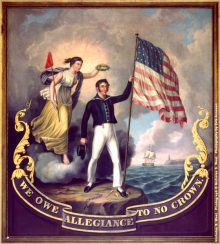MEXICAN WAR REMINISCENCES
Part III
By Judge Zo. S. Cook
(These several contributions cover the period of February to April, 1897, and were made to the Wilcox Progressive Era, published at Camden)
Article 3
About the last of December, 1847, the order came to pack for transportation to Mexico, the seat of war. A small boat ran up Three Mile Creek to the bridge on Telegraph Road. All hands got aboard, the boat backed down the creek to the river, and from thence to the bay, where a vessel was awaiting to receive us on board. This was a small sail vessel, small cabin intended for the officers of the craft only. The soldiers, about four hundred, were put below between decks. Straw was put down for bedding. The height between decks was about five feet nine inches long, enough to make a six-footer tired to walk between. The vessel got up between the pass, the sea smooth and calm, everybody full of life, some sitting around on deck, some cooking and eating, Some up in the rigging as high as they dared to go, A brisk breeze sprung up and the vessel went sailing along lively.
One by one the men began to move about trying to find an easier place to rest, when the fun began in earnest. About the-first intimation that anything was wrong was an exclamation from a sailor, “Go to leewa’d you d—n land lubber!” but they were feeling indifferent about the way the wind blew or which way they went. All got down in the hole, quite a gale sprung up, such lamentations, oaths, prayers, were never heard before. All officers and soldiers were in the same condition except three soldiers. They were Jack Sheffield, who recently died at Rehoboth, Zo S, Cook and Jesse Skinner of Arkansas. These three men were not sick but had a hard time for about four days and nights. It was water, water all the time. Such a scent in the hole of that vessel was beyond description.
VERA CRUZ
A man seasick cares for nothing. A hole under the straw where they lay was as good a place to vomit as in the gulf. The trip lasted seven days to Vera Cruz, where we landed on the first Sunday in January, 1848, The boys having gone through with the trying ordeal of sea-sickness, and packed in the hole of the vessel for seven days, were like wild beasts turned loose after being penned up for a time. The first thing that their attention was called to after landing was a pile of oranges, which they proceeded to devour. The Mexican selling them, not understanding the English language nor the capacity of a soldier’s stomach, called lustily for help. A sergeant on duty came to his relief and matters were explained satisfactorily when we were called to order, marched through the city of Vera Cruz to a camping ground about two miles north of the city. On the march to camp, a norther or gale sprung up, blowing the sand into hills wherever it could find a lodging place, such as a bush or cactus plant Many of the boys lost their caps and other articles by the force of the gale. A cap would fly off and not touch the ground while in sight, blankets were lost in the same way. Finally camp was reached about sunset, when tents were pitched and we slept for the first time that night on Mexican soil.
SNOW-CAPPED MOUNTAIN
Mention should be made of the first sight that greeted us from, the vessels as we approached the Mexican shore. In fact it was the very first object seen. This was the snow-capped mountain peak Orazaba. This mountain is about ninety miles west of the coast, and the first scene was the early morning sun, shining with all its brilliant loveliness on a mass of snow, which perpetually covers the highest peak on that range of mountains. To describe this view is out of the question. A great mass of diamonds, giving out all their lovely hues and glittering rays, could not have excelled this scene of loveliness. The purity and clearness of the atmosphere was such as to deceive the eyes and make the distance incredulous, when thinking of the miles intervening. This snow-capped mountain could be seen long before the coast or city of Vera Cruz was visible, although it was as far away.
ALABAMA REVOLUTIONARY WAR SOLDIERS VOL III
After the Revolutionary War, free bounty land was offered by the federal government to citizens and soldiers for their service. The practice of awarding bounty land for military forces had been a long-standing practice in the British Empire in North America. Land was a commodity in generous supply.
This book is the 3rd Volume in a series of books which includes genealogical and biographical information on some Revolutionary Soldiers who were in early Alabama and/or collected military pensions for their service. Some of their descendants still remain on the bounty land they received. The soldiers in this volume include: ASA CASTELLAW ALEXANDER, JEREMIAH ALEXANDER, DAVID ALLEN, ANNANIAS ALLEN, JESSE ALSOBROOK, LEMUEL J. ALSTON, JOHN AMINET/AMONETTE, THOMAS ARNOLD, CAPT. RICHARD BACON, FREDERICK BAGWELL, ELDRIDGE BAILES, MOSES BAILEY, REUBEN BAILEY, SAMUEL BAKER, JOHN BALLENGER, MORDECAI BARBOUR, ROBERT BARCLAY, NATHANIEL BARNETT, THOMAS BARNETT, WILLIAM BARNETT, WILLIAM BARRY, JAMES BURWELL BASS, URIAH BASS PETER NEWPORT BRAGG





